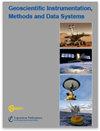Swarm Langmuir probes' data quality validation and future improvements
IF 2.3
4区 地球科学
Q3 GEOSCIENCES, MULTIDISCIPLINARY
Geoscientific Instrumentation Methods and Data Systems
Pub Date : 2022-03-24
DOI:10.5194/gi-11-149-2022
引用次数: 8
Abstract
Abstract. Swarm is the European Space Agency (ESA)'s first Earth observation constellation mission, which was launched in 2013 to study the geomagnetic field and its temporal evolution. Two Langmuir probes aboard each of the three Swarm satellites provide in situ measurements of plasma parameters, which contribute to the study of the ionospheric plasma dynamics. To maintain a high data quality for scientific and technical applications, the Swarm products are continuously monitored and validated via science-oriented diagnostics. This paper presents an overview of the data quality of the Swarm Langmuir probes' measurements. The data quality is assessed by analysing short and long data segments, where the latter are selected to be sufficiently long enough to consider the impact of the solar activity. Langmuir probe data have been validated through comparison with numerical models, other satellite missions, and ground observations. Based on the outcomes from quality control and validation activities conducted by ESA, as well as scientific analysis and feedback provided by the user community, the Swarm products are regularly upgraded. In this paper, we discuss the data quality improvements introduced with the latest baseline, and how the data quality is influenced by the solar cycle. In particular, plasma measurements are more accurate in day-side regions during high solar activity, while electron temperature measurements are more reliable during night side at middle and low latitudes during low solar activity. The main anomalies affecting the Langmuir probe measurements are described, as well as possible improvements in the derived plasma parameters to be implemented in future baselines.Swarm Langmuir探测器的数据质量验证和未来改进
摘要Swarm是欧洲航天局(ESA)的首个地球观测星座任务,于2013年发射,用于研究地磁场及其时间演变。三颗Swarm卫星上的两个Langmuir探测器提供了等离子体参数的原位测量,这有助于电离层等离子体动力学的研究。为了保持科学和技术应用的高数据质量,Swarm产品通过科学诊断持续监测和验证。本文概述了Swarm langmuirprobe测量数据的质量。通过分析短数据段和长数据段来评估数据质量,其中长数据段被选择为足够长,足以考虑太阳活动的影响。Langmuir探测器的数据已经通过与数值模型、其他卫星发射和地面观测的比较得到了验证。根据ESA进行的质量控制和验证活动的结果,以及用户社区提供的科学分析和反馈,Swarm产品定期升级。本文讨论了最新基线对数据质量的改进,以及太阳活动周期对数据质量的影响。特别是,在太阳活动高时,等离子体测量在昼侧区域更为准确,而在太阳活动低时,在中低纬度的夜侧区域,电子温度测量更为可靠。描述了影响Langmuir探测器测量的主要异常,以及在未来基线中可能实现的衍生等离子体参数的改进。
本文章由计算机程序翻译,如有差异,请以英文原文为准。
求助全文
约1分钟内获得全文
求助全文
来源期刊

Geoscientific Instrumentation Methods and Data Systems
GEOSCIENCES, MULTIDISCIPLINARYMETEOROLOGY-METEOROLOGY & ATMOSPHERIC SCIENCES
CiteScore
3.70
自引率
0.00%
发文量
23
审稿时长
37 weeks
期刊介绍:
Geoscientific Instrumentation, Methods and Data Systems (GI) is an open-access interdisciplinary electronic journal for swift publication of original articles and short communications in the area of geoscientific instruments. It covers three main areas: (i) atmospheric and geospace sciences, (ii) earth science, and (iii) ocean science. A unique feature of the journal is the emphasis on synergy between science and technology that facilitates advances in GI. These advances include but are not limited to the following:
concepts, design, and description of instrumentation and data systems;
retrieval techniques of scientific products from measurements;
calibration and data quality assessment;
uncertainty in measurements;
newly developed and planned research platforms and community instrumentation capabilities;
major national and international field campaigns and observational research programs;
new observational strategies to address societal needs in areas such as monitoring climate change and preventing natural disasters;
networking of instruments for enhancing high temporal and spatial resolution of observations.
GI has an innovative two-stage publication process involving the scientific discussion forum Geoscientific Instrumentation, Methods and Data Systems Discussions (GID), which has been designed to do the following:
foster scientific discussion;
maximize the effectiveness and transparency of scientific quality assurance;
enable rapid publication;
make scientific publications freely accessible.
 求助内容:
求助内容: 应助结果提醒方式:
应助结果提醒方式:


